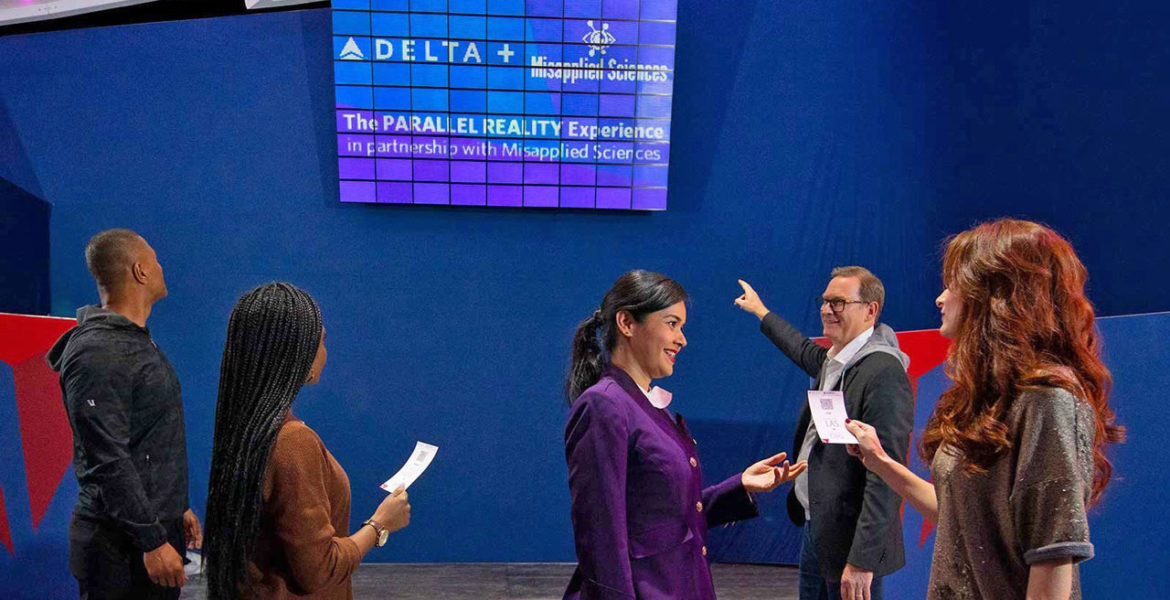Buzz surrounding personalization was ever-present at CES 2020 in Las Vegas this January, spanning health and wellness and home tech to entertainment and marketing. The heightened focus reflects rising expectations from consumers; 80% of frequent shoppers say they only buy from brands who personalize their experience. It’s a feat that can be harder for brands to pull off in the physical realm than the digital one, but Delta may have found an innovative solution.
During his CES keynote earlier this month, Delta CEO Ed Bastian announced an upcoming beta test of an experience that Delta has dubbed “Parallel Reality.” The opt-in technology will allow up to 100 travelers departing Detroit Metropolitan Airport to see personalized content tailored to their individual journey on a single screen, each at the same time and in their preferred language.
CES attendees were given a preview of the experience on the showroom floor. It worked like this: After being greeted by a gate agent, we were instructed to enter our personal information via a tablet, select our preferred language, and choose one of four cities for our trip simulation. In a nod to privacy—another major topic of conversations at CES—a message popped up that read, “We do not save personal information. Your data has been cleared.”
After receiving a personalized boarding pass based on our selection, we were ushered into a neighboring room where a Delta ambassador explained that the technology behind us would allow us to view the same screens simultaneously and see completely different things. When we turned around, the screens did indeed appear to transform, revealing images of our destinations that moved with us as we moved around the space.
Next, we scanned our boarding passes at a kiosk and were ushered into the following space, where a single screen greeted us by name and revealed our boarding and gate info in our preferred language. Once again, the information then followed us as we moved throughout the room. When I snuck behind my fellow passenger to view the screen from his position, my named and boarding info changed to his. In a playful move, the screen also displayed a message that could be read from the vantage point of those forming in the lengthy queue. It read, “Yes, this is definitely worth the wait.”
Delta created the experience in partnership with Misapplied Sciences. According to a release, the startup’s Parallel Reality technology first caught the eye of innovation experts at The Hangar, Delta’s innovation center. From there, Delta identified an opportunity to leverage it to transform the airport experience—a step towards the company’s larger mission of making travel less stressful and more enjoyable for customers. For the upcoming trial in Detroit, Delta expects tailored messages to include personalized wayfinding, flight information or updates, boarding time, the nearest Delta Sky Club and upgrade or standby status, but the implications of the technology could reach well beyond the airport.
In the realm of OOH advertising and marketing, messages could be targeted to each viewer’s needs, interests, and surroundings—a concept that fans of Minority Report will find familiar. In experiential marketing and entertainment, tailored lighting effects and messages could be individualized to each viewer, giving them their own unique viewing experience. The hospitality industry could also see the benefits of technology’s language applications, which allows people from around the world to view messages in the native tongue.
For Delta and others who adopt Parallel Reality, success may rely on making sure that marketing efforts don’t cross the line from helpful to invasive. Even though technology is opt-in, many consumers harbor concerns about how companies use their information. Brands may find that younger consumers, who’ve grown up with personalization and have a notably optimistic view of technological innovations—84% think technology can build a better tomorrow, per a study for the Varkey Foundation—are the most receptive to it.
Notably, Parallel Reality was a high-tech experience in which the technology seemed to fade into the background. No headsets or apps were required during the CES simulation. Instead of making tech the focal point, the individual’s needs were the focus, which speaks to the heart of personalization’s popularity with consumers. If the technology succeeds, that will likely be a major reason why.

